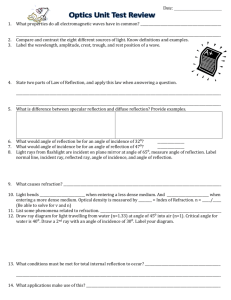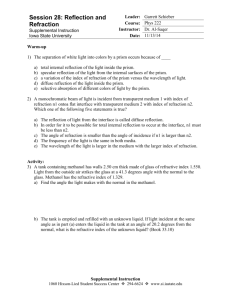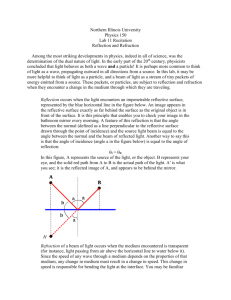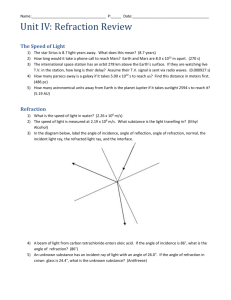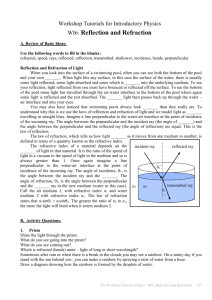Definitions – Chapters 2-5 Reflection is defined as the bouncing of
advertisement
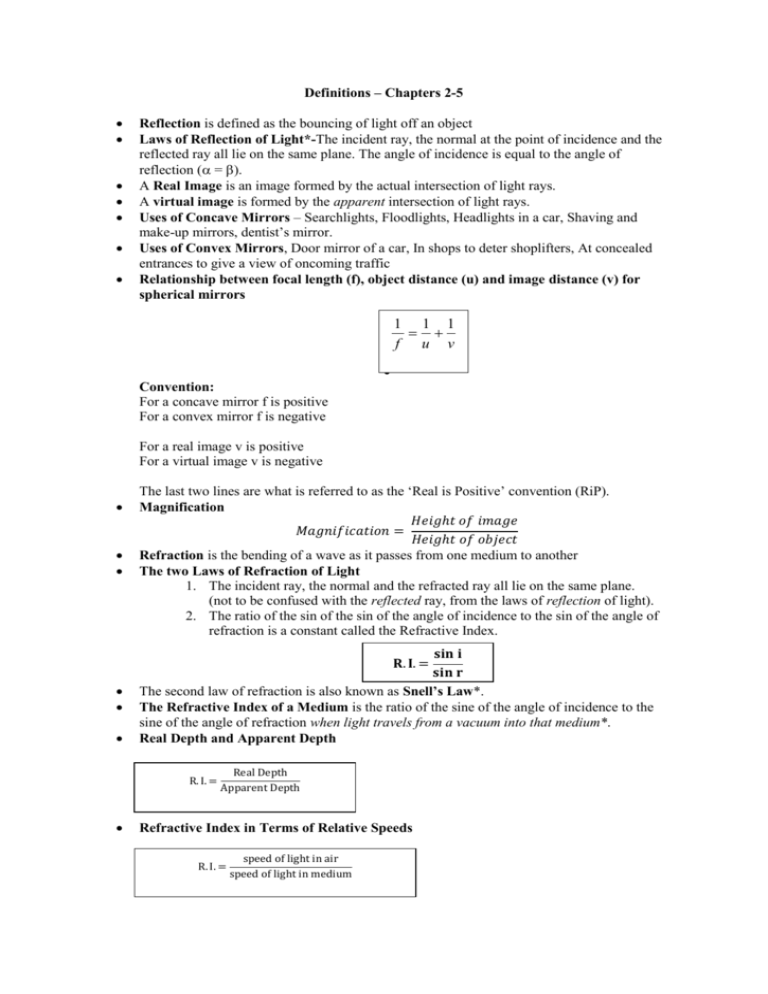
Definitions – Chapters 2-5 Reflection is defined as the bouncing of light off an object Laws of Reflection of Light*-The incident ray, the normal at the point of incidence and the reflected ray all lie on the same plane. The angle of incidence is equal to the angle of reflection ( = ). A Real Image is an image formed by the actual intersection of light rays. A virtual image is formed by the apparent intersection of light rays. Uses of Concave Mirrors – Searchlights, Floodlights, Headlights in a car, Shaving and make-up mirrors, dentist’s mirror. Uses of Convex Mirrors, Door mirror of a car, In shops to deter shoplifters, At concealed entrances to give a view of oncoming traffic Relationship between focal length (f), object distance (u) and image distance (v) for spherical mirrors 1 f 1 1 u v Convention: For a concave mirror f is positive For a convex mirror f is negative For a real image v is positive For a virtual image v is negative The last two lines are what is referred to as the ‘Real is Positive’ convention (RiP). Magnification 𝐻𝑒𝑖𝑔ℎ𝑡 𝑜𝑓 𝑖𝑚𝑎𝑔𝑒 𝑀𝑎𝑔𝑛𝑖𝑓𝑖𝑐𝑎𝑡𝑖𝑜𝑛 = 𝐻𝑒𝑖𝑔ℎ𝑡 𝑜𝑓 𝑜𝑏𝑗𝑒𝑐𝑡 Refraction is the bending of a wave as it passes from one medium to another The two Laws of Refraction of Light 1. The incident ray, the normal and the refracted ray all lie on the same plane. (not to be confused with the reflected ray, from the laws of reflection of light). 2. The ratio of the sin of the sin of the angle of incidence to the sin of the angle of refraction is a constant called the Refractive Index. 𝐬𝐢𝐧 𝐢 𝐬𝐢𝐧 𝐫 The second law of refraction is also known as Snell’s Law*. The Refractive Index of a Medium is the ratio of the sine of the angle of incidence to the sine of the angle of refraction when light travels from a vacuum into that medium*. Real Depth and Apparent Depth 𝐑. 𝐈. = R. I. = Real Depth Apparent Depth Refractive Index in Terms of Relative Speeds R. I. = speed of light in air speed of light in medium Total internal reflection occurs when the angle of incidence in the denser of the two media is greater than the critical angle and light is reflected back into the denser medium. The critical angle corresponds to the angle of incidence in the denser of two media which causes the angle of refraction to be 900. Relationship between Critical Angle and Refractive Index* 𝑹. 𝑰. = 𝟏 𝒔𝒊𝒏 𝑪 Applications of Total Internal Reflection - Reflective road signs, Optical Fibres, Endoscopes, Periscopes Relationship between focal length (f), object distance (u) and image distance (v) 1 1 1 f u v Convention: For a convex lens f is positive For a concave lens f is negative For a real image v is positive For a virtual image v is negative Power of a Lens = 1/focal length (The unit of power is m-1.) 𝑃= 1 𝑓 If two lenses of power P1 and P2 are placed in contact, the power P of the combination is given by PTotal = P1 + P2 It follows from this that if two lenses of focal length f 1 and f2 are placed in contact, the focal length f of the combination is given by 1 𝑓𝑇𝑜𝑡𝑎𝑙 = 1 1 + 𝑓1 𝑓2 Short Sight A Short-sighted person can see nearby objects clearly but cannot bring distant objects into focus. Long Sight A Long-Sighted person can see distant objects clearly but cannot bring nearby objects into focus.


